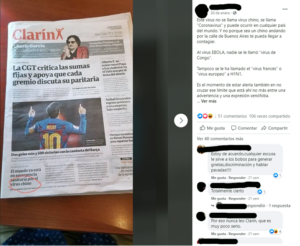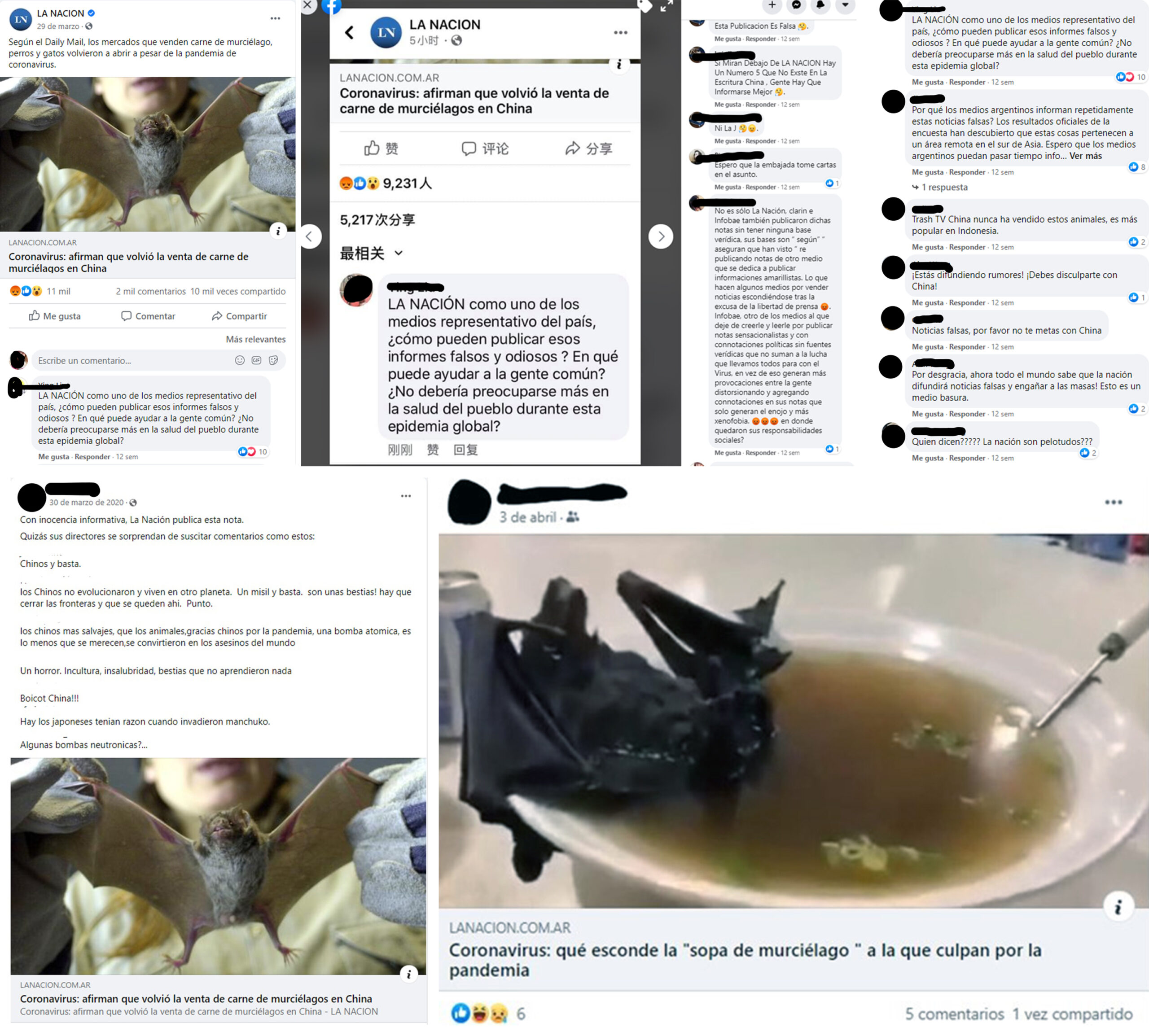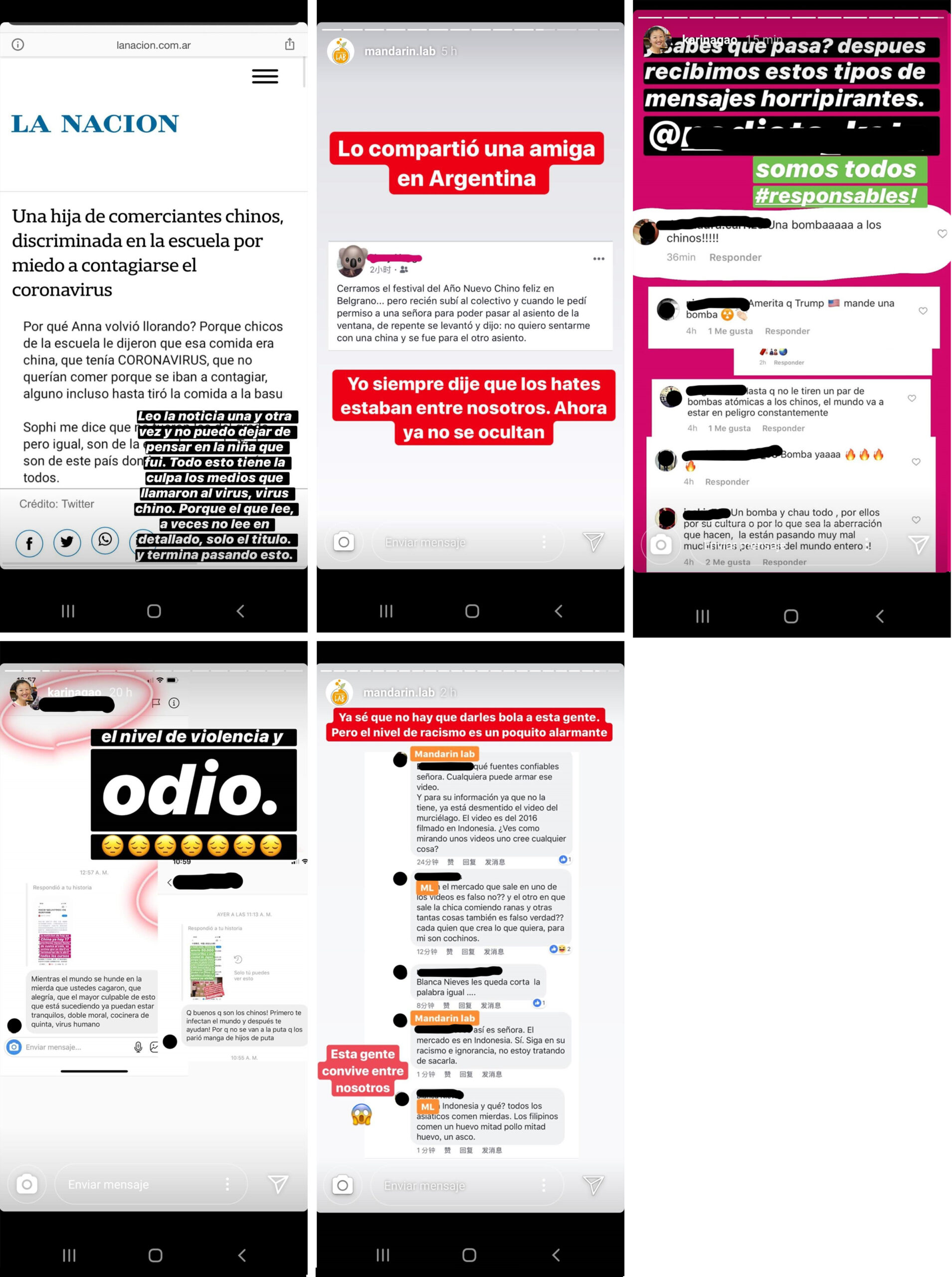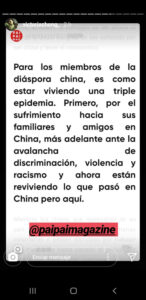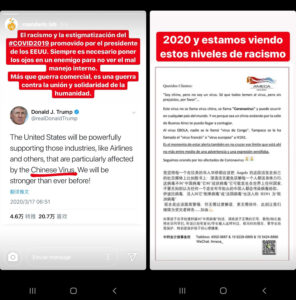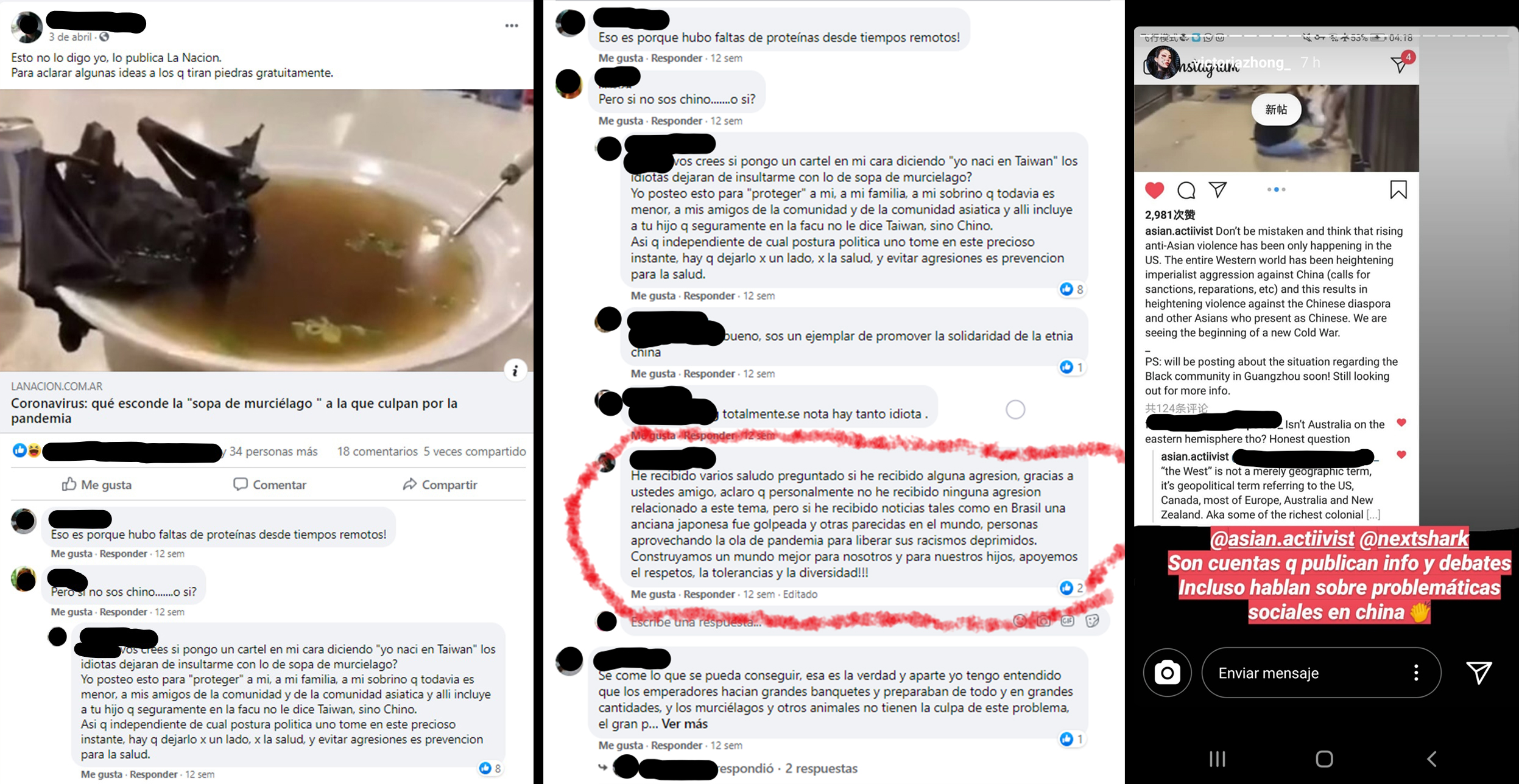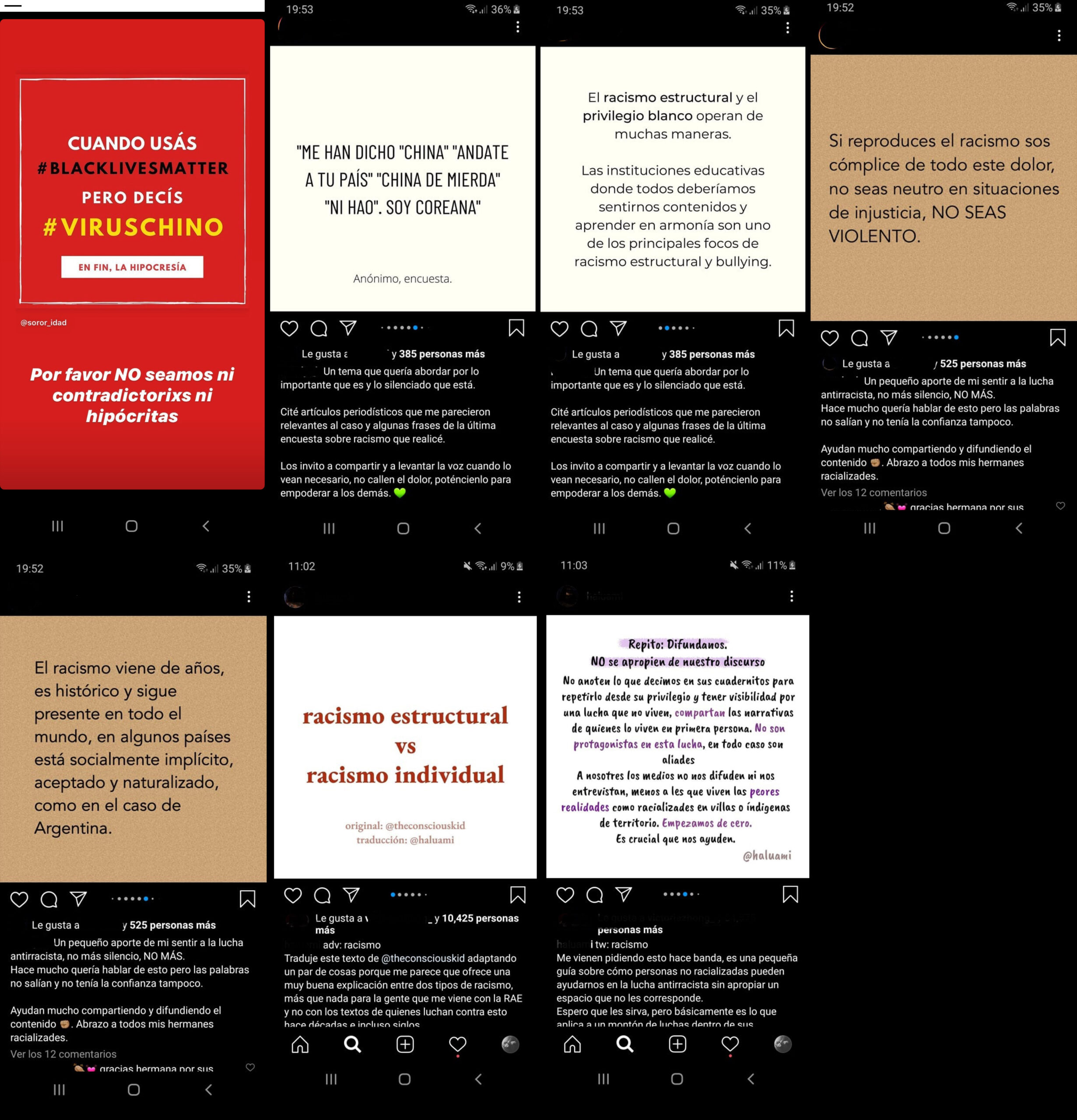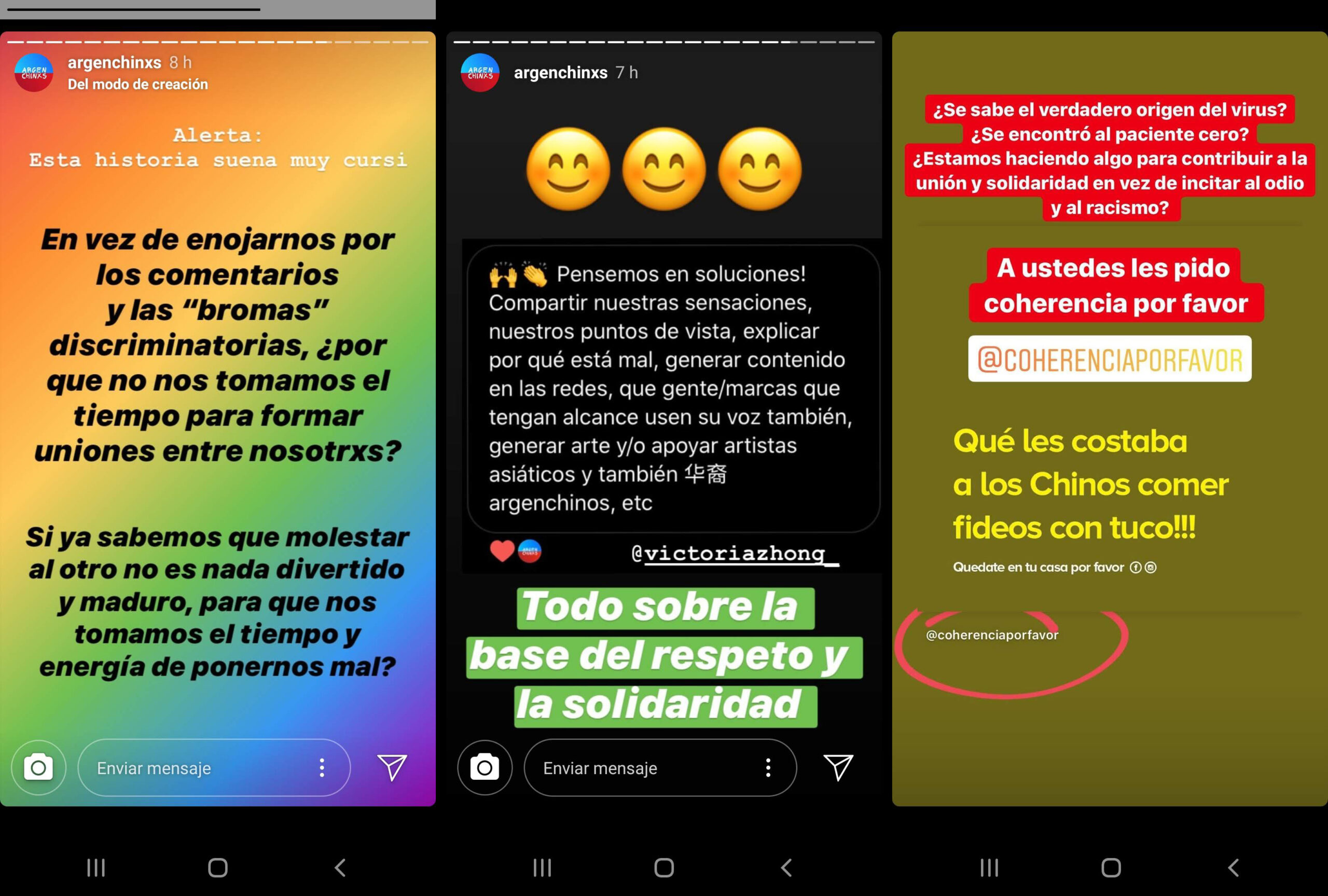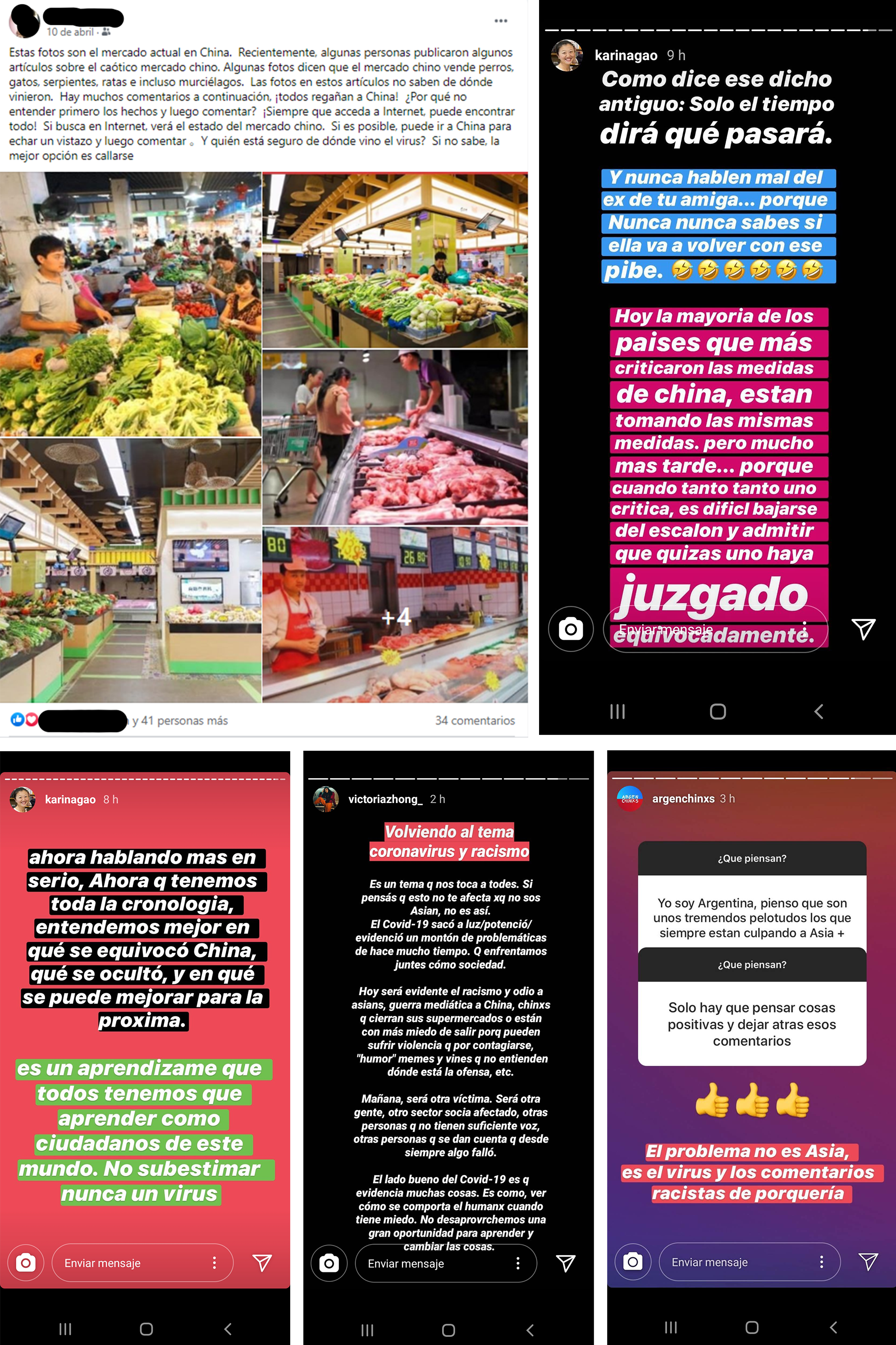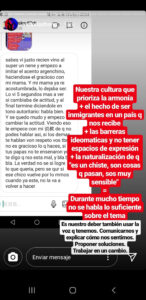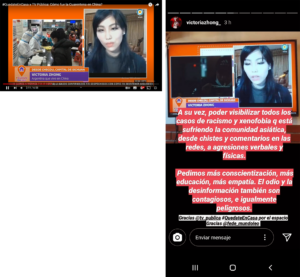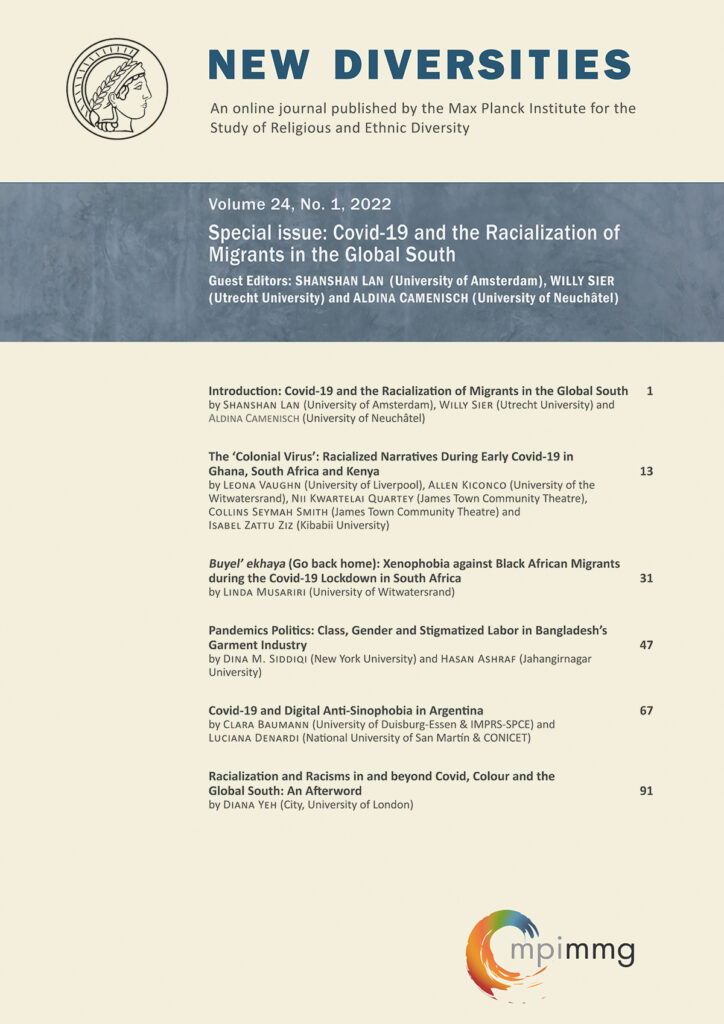New Diversities • Volume 24, No. 1, 2022
* The authors would like to thank the organizers, participants, and discussants of the ChinaWhite International workshop “Racialisation and Social Boundary Making in Times of Covid-19”, (2-4 December 2020), as well as their anonymous reviewers, for their valuable feedback and contributions to this article.
** Corresponding author. Contact: baumann@mpifg.de.
To cite this article: Baumann, C., & Denardi, L. (2022). Covid-19 and Digital Anti-Sinophobia in Argentina. New Diversities, 24(1), 67–89. https://doi.org/10.58002/f6sw-1096
Abstract:
While racial discrimination against people of Asian and particularly Chinese origin is well-understood in the Global North, its dynamics in the Global South remain under-investigated. Moreover, although Covid-19 contributed significantly to the reinforcement of sinophobic stereotypes around the globe, recent research has barely paid any attention to new forms of counter-reaction, such as those that evolve in digital channels, especially in Latin America. This paper sheds light on anti-Asian racism and the digitized counter-reactions of Chinese migrants before and after Covid-19 in the crucial case of Argentina. In the past, these migrants mostly remained silent when confronted with institutional racism. However, it was precisely the outbreak of Covid-19 that contributed to the creation of new forms of empowerment on online platforms by this racialized minority and that allowed them to present their demands to state agencies and to denounce sinophobic debates on social media. Methodologically, this study combines elements of process-tracing with both traditional and online ethnographic methods to explain these trickle-up effects.
Keywords: digital empowerment, Sinophobia, Covid-19, Argentina, online ethnography
Introduction
The global outbreak of Covid-19 in December 2019 severely increased racial discrimination against Chinese communities around the world. After the first cases were discovered in the Chinese city of Wuhan, Chinese people were quickly stigmatized as scapegoats for its outbreak and global spread. In the case of Argentina, the already vulnerable Chinese and Asian minorities not only became subject to increased exclusion since the first Argentine case of Covid-19 was officially confirmed in March 2020, they also experienced increased discrimination from the very beginning of the pandemic. These dynamics of racialization were intensified by global political narratives equating Covid-19 with the ‘Chinese virus’, reinforced by insults and memes shared through online platforms.
Following Reeves (1983, cited by Murji and Solomos 2005: 17), we define racialization as ‘a process through which race is adopted in situations in which it was previously absent’, and agree that ‘racialization occurs in any case where race is increasingly used descriptively’. Moreover, we understand racism as cognitive, behavioural and structural forms of reservation and discrimination against specific ethnic groups that are homogenized and associated with one or more seemingly intrinsic characteristics (see Jonas and Schmid Mast 2007). Finally, we agree with Mullings (2005: 684) in considering racism to be a relational concept that transforms perceived differences into multiple forms and struggles involving inequality, including ‘subordination, stigmatization, exploitation, exclusion, various forms of physical violence, and sometimes genocide’.
Usually, racialization derives from legacies of colonialism and imperialism, causing uneven power dynamics among different groups of society, migrants and their descendants. In this context, we define Sinophobia as one particular form of racism that is directed against people of Chinese and often Asian descent more broadly.
Before the outbreak of Covid-19 in Argentina, multiple aspects such as the strong competition between Chinese and domestic merchants and caterers, as well as cultural misunderstandings, language barriers and urban myths, had already shaped an often strong social distance between Argentinians and Chinese immigrants. This situation had already provoked numerous prejudices and anti-Chinese racial discrimination (Tang 2011). Yet, before the pandemic, only isolated responses to these racist episodes could be observed (e.g., Antonio Chang 2013). In contrast – and in line with global developments in, for example, France (Wang et al. 2020) or the UK (Yeh 2020) – during the pandemic the racialization processes described above increasingly caused counter-reactions by the formerly rather ‘silent’1 Chinese minority in Argentina (Denardi 2020). Interestingly, this movement has been especially supported by second-generation and younger Chinese immigrants between the ages of 20 and 40, who usually speak fluent Spanish and have reached high levels of education. However, first-generation and older immigrants have also followed up on their actions.
At this point, it is essential to clarify that we agree with Rubio (2021) that racism cannot simply be challenged in interpersonal relationships or by applying specific steps and measures to correct individualized behaviour.2 On this basis, we acknowledge that the counter-reactions to sinophobic discrimination described in this study are at too early a stage to consider them an anti-racist movement. However, we consider measures to reveal, explain and correct individual behaviour, particularly in the case of the formerly silent minority of Chinese and Asian immigrants in Argentina, as crucial steps in initiating broader anti-racist movements.
While Covid-19 thus enhanced a major shift in the anti-sinophobic empowerment of Chinese communities in Argentina from individual to collective responses, the causal mechanism leading to this outcome remains black-boxed. Even less attention has been paid to the digital dimension as an important driver of these new waves of empowerment. However, an extensive analysis of these gaps is crucial not only in understanding contemporary processes of racialization and the effects of the pandemic on social movements, but also in exploring future opportunities for Chinese migrant communities to react to Sinophobia and reduce it.
In this study, we argue that digital channels, which gained in importance throughout the pandemic, provide a new space in which to respond to institutionalized racism. In contrast to traditional approaches to digital racism, we thus introduce the notion of digital counter-reactions to institutionalized racism and Sinophobia as the framework for this study and as a new concept for analysis in future research.
Based on the empirical gaps mentioned above, our research thus responds to two different strands of theoretical literature. In line with Reeves (1983, cited in Murji and Solomos 2005), we understand racialization as a form of political mobilization,3 indicating awareness of its existence and the necessity to remove discrimination from racialized groups. On this basis, Mullings (2005) highlights the necessity to explore new forms of racialization that generate new types of anti-racist mobilization. We argue that digital mobilization is one of these new anti-racist dynamics: generally, the mainstream literature on digital racism explains the persistence of (Daniels 2013) or increases (Ekman 2019) in racism with reference to an online disinhibition effect (Suler 2004). In this sense, online platforms are generally analysed as fabrics enhancing (Matamoros-Fernández 2017) or denying (Nelson 2013) racist discourses. A rare exception to this trend is Rosa and Bonilla’s study (2015) of the importance of hashtag usage on online platforms to enhance digital protest on Twitter as part of the ‘Black Lives Matter’ movement, mainly in the United States. Similarly, in this study, we show how social media can be used as a platform to organize and reduce racist discrimination. In particular, we focus on the implications of digital movements in the context of South-South migration.
On this basis, we aim to answer the following questions: How can we conceptualize the gradual emergence of the digital empowerment of Chinese minorities during Covid-19 as new types of counter-reaction to institutionalized racism? More precisely, starting with the outbreak of Covid-19 at the end of 2019, which incidents and processes were necessary to encourage Chinese migrants and their descendants in Argentina to raise their voices against racial discrimination?
Methodologically, we apply elements of process-tracing as proposed by Beach and Pedersen (2013). As this method is designed to explain the causes of a particularly interesting outcome, the analytical approach requires several iterative steps of both theory-testing and theory-building based on empirical observations. Specifically, we apply the variant of explaining outcome process-tracing, which, following Beach and Pedersen (2013), has as its specific goal the inductive search for a minimally sufficient explanation for a particularly puzzling outcome in a particular case. This approach allows us not only to structure our empirical results both conceptually and chronologically, and thereby to identify the different subsequent steps that were necessary for Chinese immigrants and their descendants in Argentina to organize themselves: it also enables us to understand how various gradual changes could accumulate in the outcome of organized anti-sinophobic action. This includes not only the organized defence and counteractions of Chinese immigrants themselves, but also the increasing support of them from the rest of Argentine society. In this context, conceptually, we draw on theoretical considerations of institutional change to racist discourses.
Latin America and the Caribbean (LAC), and especially Argentina, provide crucial cases for analysis for a number of reasons. On the one hand, the main foci of studies on Asian and Chinese immigration in LAC remain the often strong cultural ties of Asian emigrants to their countries of origin (e.g., see Tsuda (1999) on Japanese in Brazil), as well as their different integration strategies within their host societies (see Labarca (2015) on Chinese in Chile or Lausent-Herara (2014) on Chinese in Peru). However, their findings barely reveal how Asian immigrants in LAC experience explicit racial discrimination.
On the other hand, the literature on racialization mainly highlights the denial of racism in the region (see Dulitzky 2005), while those studies that acknowledge its existence focus on indigenous people and mestizos rather than immigrants from abroad (see Golash-Boza and Bonilla-Silva 2013). Data on the racialization of ‘lighter-skinned groups such as Asians’ in Latin America and ‘white supremacy’ over them remain scarce (see Sue 2009: 1062). As a rare exception, Chan and Montt Strabucchi (2021) trace how racist discrimination against Chinese immigrants has evolved in Chile along with Covid-19, and how these dynamics increased previously existing anti-Chinese sentiments in the country. While thereby providing important evidence on how the pandemic enhanced global Sinophobia, they barely pay any attention to whether Chinese communities reacted to this newly evolving racism, and if so to what extent.
However, both racial discrimination against ethnic Chinese immigrants and their responses to these dynamics have become increasingly visible in the region and require further empirical research. Within Latin America, the atypical scope condition of an explicitly silent minority that had long been discriminated against without their resorting to political mobilization makes Argentina a particularly interesting case.
Empirically, this study is based on extensive online ethnography defined as ‘the specificity of ethnographic methodology when it is carried out online, even when it does not end in nor is exhausted by it’ (Di Próspero 2017: 49). Specifically, we focus on social networks that enable their users to share their thoughts, to exchange texts and images with a global audience, and to create high levels of visibility within seconds.
In Argentina, the two most popular digital platforms are Instagram and Facebook (Ovrik 2018). Based on their high reach, we thus selected these two providers as the main sources of data for this paper. Moreover, the frequent use of these two platforms by numerous Chinese immigrants in Argentina implies their intention to interact actively with the host population.4,5
We collected and analysed empirical data from a sample of more than 400 related statements and discussions published by Chinese immigrants, their descendants and members of their Argentinian host society between December 2019 and June 2020. For this paper, we selected around 40 screenshots of publications with the highest analytical value for our research question, based on their detailed descriptions of current developments. Moreover, they were published by Chinese immigrants with high numbers of followers, whose content was frequently shared. As one general effect of Covid-19 was the extensive use of digital media to communicate, the increasing number of published statements, both racist and anti-racist, on social networks mirrored real-time developments.6
Historical Background: Chinese Migration to Argentina
In contrast to most Latin American countries, Chinese migration to Argentina began relatively late. First, since the late 1970s, both wealthy merchants and political refugees mainly from Taiwan came to settle in and around Buenos Aires by bringing sufficient money to buy houses and set up their own businesses. Second, throughout the 1990s, several groups of economic migrants from the economically less advanced province of Fujian came with little financial capital and high hopes of finding economic prosperity in Argentina (Denardi 2017).
After the Argentine economic crisis of 2001, these initial settlers were followed by an estimated 200,000 immigrants from mainland China. Lacking Spanish language skills, they focused on opening small supermarkets selling domestic Argentinian groceries. While these activities led to the urban dispersal of the former Chinese ‘community’, they also increased their competition with domestic merchants. As well as facing strong cultural and linguistic barriers separating them from the host society, these Chinese supermarket owners quickly became the targets of racist prejudices and discrimination (Denardi 2017).
Finally, throughout the 2010s, Chinese multinational companies (MNCs) gradually began to enter the Argentinian market, often bringing highly trained professionals from China with them. Yet, due to their status as temporary residents, these new immigrants generally remained separated from the Argentinian host society (Denardi 2017).
To date, an estimated 80 percent of all Chinese immigrants in Argentina consist of supermarket owners and their employees, while the remaining 20 percent mainly include employees of Chinese MNCs and individuals engaging in the import and export sectors (unofficial data provided by our interlocutors).
In the past, to protect themselves from racial discrimination, these different immigrant groups generally engaged in welfare activities, such as donating money to hospitals and poor neighbourhoods, rather than engaging in public protest. Moreover, the lack of support by official Chinese agencies speaking out against discrimination complicated the organization of structured movements other than fragmented responses or charity work. However, we suggest that this situation is changing with the younger generations, who were born in Argentina, speak fluent Spanish and Chinese, and grew up within a highly agitated Argentine environment shaped by struggles for human rights and mutual respect.
Theoretical Background
Institutionalized Racism in Argentina
Following Djelic and Quack (2008: 300), we define institutions as ‘those collective frames and systems that provide stability and meaning to social behaviour and social interaction and take on a rule-like status in social thought and action’, as well as ‘tools and resources enabling action’. On this basis, to disentangle the different dimensions enhancing the organized anti-sinophobic initiatives of the Chinese community in Argentina, it is useful to approach racism from an institutionalist perspective. First, we follow España Eljaiek (2017: 31) in her general definition of racial exclusion as ‘sets of relationships’ and ‘an informal dynamic institution [entailing] permanent conflicts and tensions and simultaneous processes of institutional change and reinforcement’. Second, we identify specific elements of ‘traditional’ institutional racism directed against Chinese immigrants in Argentina.
According to Carmichael et al. (1992: 4), institutional racism is characterized by ‘far more subtle’ forms of discrimination that are more widely tolerated than individually expressed racism. Historically, institutionalized forms of racism included both general prejudices and the resulting discriminatory behaviour, as well as concretely manifested state acts (e.g., Bourne 2001: 9-10) that reinforce the benefits of the ‘white’ members of a society vis-à-vis other ethnic minorities (Better 2008). More specifically, institutional racism is characterized by repetitive patterns of both the acceptance and reinforcement of white supremacy via different institutions: these often relate to economic, social and psychic advantages and are generally manifested by both formal and informal policies and laws (ibid.).
The discourse of ‘whiteness’ in Argentina is important for understanding the racialized dynamics in the country. According to Lan (2011) the racialization of Chinese migrants is mediated by the racialization of other minorities. The basis of these ‘overlapping racializations’ (ibid.: 7) dates back to colonial times and the myth that Argentines ‘descended from the boats’ bringing white Europeans to the country (Sutton 2008: 107). On this basis, throughout the following centuries, the Argentine authorities consistently encouraged the arrival of both these initially white colonialists and the white immigrants who followed them. In contrast, other ethnic minorities, including indigenous people, non-white immigrants and their descendants labelled as ‘others’, were increasingly excluded, which reinforced white supremacy. In particular, the Argentine state fostered racism, initially through multifaceted policies such as strict immigration laws, military campaigns and discriminating narratives against foreign and non-white residents. Moreover, even with the gradual inclusion of anti-racist laws in the Argentine legal landscape, protective measures have barely been implemented (ibid.).
While these general dynamics apply to most non-white ethnicities, Chinese immigrants appear to be among the most severely affected minorities by both institutional and individual racism and exclusion in Argentina (Adaszko and Kornblit 2008). The absence of any concrete state action to counter these dynamics is a final indicator of the long-maintained institutional Sinophobia in Argentina. While these more subtle forms of discrimination could already be observed before the outbreak of Covid-19, the global spread of the pandemic enhanced the tolerance of racist prejudices and attacks against ethnic Chinese within Argentinian society.
Within these structures, the Chinese community in Argentina gradually found various ways to make its own voice heard. To explain these dynamics, we turn towards theories of institutional change that serve as the heuristic framework for our further analysis.
Institutional Change
As shown by Djelic and Quack (2003, 2008), institutional change in both domestic and transnational spaces may be attributed to either ‘trickle-up’ or ‘trickle-down’ trajectories. On the one hand, trickle-down effects refer to national or transnational institutions being challenged by supranational or non-governmental organizations. As a result, transnationally negotiated agreements and guidelines are implemented top-down, though often without binding force. In this case, (sub-)national authorities are pressured to enforce rules directly at the national level, for example, by integrating them into national law. On the other hand, trickle-up effects occur more indirectly and bottom-up: individual subnational actors and groups may challenge the dominant models by informally introducing and acting according to new and innovative rules of the game. As a result, small changes may contribute to incremental bottom-up processes, ultimately leading to significant renewals.
Moreover, institutional change may be initiated through different mechanisms, enhancing either sudden or gradual transformations. Among these, the process of displacement in particular implies a ‘slowly rising salience of subordinate relative to dominant institutions’ through ‘defection’, often by adapting foreign practices (Streeck and Thelen 2005: 31; Quack and Djelic 2005).
Although these mechanisms primarily refer to economic and political contexts, their implications may be directly translated into general institutional changes, including those of racist discourses. As stated above, the dominant rules within the national context of Argentina consist in the often subtle forms of discrimination and exclusion of ethnic Chinese due to numerous prejudices that have become aggravated in the context of Covid-19. Although the stigmatization of Chinese people as scapegoats for the crisis has become a global phenomenon, so far Argentinian7 and transnational authorities have barely raised their voices against the related sinophobic attacks. Consequently, the discriminated minority of Chinese immigrants in Argentina could neither hope for trickle-down effects improving their social standing from a transnational perspective, nor for direct top-down initiatives within their host country. Instead, they were required to seek their own channels of empowerment from the bottom up. Finally, we argue that a decisive indicator of their successful bottom-up dynamics was their increasing organization: incipient movements ‘are characterised by informal, diffuse and hidden types of organization or “networks in the everyday”’ (Waters 2003: 72, italics added).
The goal of the following empirical sections is to trace how Chinese immigrants in Argentina organized themselves to challenge institutionalized racist structures from the bottom up. Generally, we look at this process as a gradually established movement aimed at introducing institutional change through displacement, that is, collecting arguments and raising their own voices as a formerly subordinate minority against the dominant sinophobic discourses.
New Answers to Old Questions
Below, we identify three different phases of digital anti-Sinophobia based on internal developments, external influences and their combination in enhancing an increasingly organized movement in Argentina. While all three phases rapidly evolved after the initial outbreak of Covid-19 and partially overlapped with each other, below they are idealized for the purpose of clarity. Thus, in contrast to Beach and Pedersen (2013), we do not presume strict causality but acknowledge the inherently unstructured nature of human action and reaction.
First Phase: Internal Influences
I. Identification of Increasingly Sinophobic Mediatic Discourses
The first steps towards an organized movement were enhanced by collective statements against media narratives.8. In January 2020, the Argentine newspaper Clarín took up the global narrative of the ‘Chinese virus’ and introduced it to the country: ‘The world is already in a health emergency because of the Chinese virus’ (Clarín 2020a). By then, the Chinese community already began to identify the increasing danger of media narratives on Covid-19 to reinforce racist prejudices: the direct link made between the virus and their ethnicity allowed the stigmatization of Chinese immigrants not only as scapegoats for the crisis, but also as dangerous to public health. Thus, claiming that previous diseases had not been identified by their country of origin, the Chinese community in Argentina asked media institutions to stop referring to Covid-19 as the ‘Chinese virus’ (1)9 and avoid potential stigma.
As underlined by different statements by both Chinese migrants and Argentinian citizens, this perception of news media as a main source of potentially reinforced racism spread quickly. Among others, an Argentine friend of a Chinese immigrant10 directly stated her concern at the public media causing a panic by spreading images of ‘bat soup’ and wild animals in Chinese food markets (2). Simultaneously, she emphasized the importance of understanding cultural sources, instead of spreading prejudices without further reflection. Other Chinese migrants stated that Clarín was ‘not to be taken seriously’ (3)11 and criticized the lack of public solidarity with them as victims, wondering how ‘nobody thought “Hey, I think it’s not okay to write in this way” ’ (4).
This monitoring of headlines and media content by numerous interlocutors on both Facebook and Instagram continued throughout the pandemic and increased with the first confirmed Argentinian case of Covid-19 in early March 2020. The first infected patient was reported by Clarín, which once more used the racialized term the ‘Chinese virus’ as having arrived in Argentina (Clarín 2020b). Simultaneously, Clarín (Clarín 2020c) publicly denounced the seemingly bad hygienic standards of Chinese food markets. Again, Chinese immigrants reacted by increasingly pointing out their concern at public media severely shaping sinophobic discrimination, denouncing Argentinian news media as ‘garbage’ and ‘always very diabolical’. Simultaneously, the number of Argentinian supporters of Chinese people fighting racism increased significantly (e.g., 5).
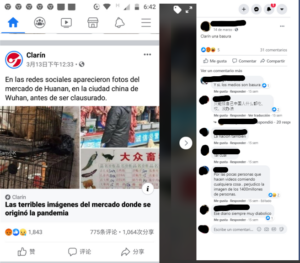
Figure 5
Partially, these collective actions led to media counterstatements to falsified publications. Among others, an announcement by La Nación (La Nación 2020), claiming that traders in China had returned to selling bat meat again, had caused further large waves of protests, including practices of ‘naming and shaming’ (e.g., 6a, 6b, 7) and claims that such markets only existed in ‘Southern parts of Asia‘‘ outside China (6c). Consequently, three days after the initial publication, La Nación (Willie 2020) published a second article highlighting the need to differentiate among different nations within Asia and their heterogeneous cultures and habits. As a result, several prejudices against Chinese people that La Nación itself had reinforced through its first article were dispelled. Again, Chinese residents in Argentina repeatedly shared this counterstatement on social media (e.g., 8).
These dynamics revealed the capacity of the formerly unheard Chinese minority to find their own voices and initiate broader changes from the bottom up, encouraged by the racism that had been aggravated throughout the pandemic. However, as the pandemic went on, the scapegoating of Chinese immigrants for its outbreak did not remain a mere media narrative but increased the direct discrimination they faced.
II. Identification of an Increasingly Directly Expressed Sinophobia

Figure 9
Despite their initial efforts to avoid their stigmatization, Chinese and Asian immigrants experienced a rapid increase in racist discrimination by the Argentinian host population. Thus, in a second step, they publicly discussed their personal experiences while accusing media narratives of having directly enhanced these consequences.
1. Identification of subtle racist expressions. In a first step, general and more subtle expressions of racism were uncovered. In this context, one of the main ideas promoted by migrants on social media was that a joke could also express discrimination. Moreover, numerous Instagram users published calls to stop sharing offensive memes and to pay attention to the racist content of jokes (9: ‘Your racist comments and jokes are more dangerous than Covid-19’).
2. Identification of concrete experiences with harassment and exclusion. Beyond jokes, the experience of a second-generation Chinese immigrant called Anna best exemplifies both the enhanced Sinophobia and the increasingly organized counterreactions in Argentina (Tronfi 2020). At school, her Argentine classmates identified her as a particularly dangerous transmitter of the virus and started to exclude her and harass her (ibid.). This incident immediately caused heated debates on social media. Among others, numerous Chinese immigrants claimed that ‘all of this was the fault of the media who named the virus the Chinese virus’ (10). Subsequently, they continued to publish, reflect and comment on and share their personal experiences of racist attacks on digital platforms. Therefore, building on the first phase of raising awareness to the danger of media narratives enhancing racism, the formerly silent Chinese migrants in Argentina gradually made their own voice heard (11, 12, 13, 14).
Second phase: External Influences
The first initiatives towards an anti-sinophobic movement in Argentina did not derive only from domestic developments and enhanced discrimination but were, in a second phase, also inspired by multi-layered external and transnational influences.
1. Globally increasing Sinophobia and countermovements. In a first step, individual Chinese immigrants found and shared publications addressing and criticizing Sinophobia in third states, thereby encouraging their own communities to respond in a similar way. At first, a Spanish magazine had identified ‘an avalanche of discrimination, violence and racism’ being experienced by members of the Chinese diaspora (15). This statement was discovered and distributed by a descendant of Chinese migrants to Argentina: by sharing it on social media, he drew attention to the global dynamics of anti-Chinese racism. This adoption of foreign statements in Argentina exemplifies not only the rapid spread of sinophobic narratives around the globe, but also the strong transnational connections of Chinese migrant communities and their ability to adapt domestically to globally enhanced initiatives.
Secondly, global political discourses were increasingly contested. In particular, the prominent use of the term the ‘Chinese virus’ and its negative connotations by Donald Trump, then President of the United States, was sharply criticized: his public twitter post claiming that the ‘Chinese virus’ was harming numerous US industries (17.03.2020) caused waves of counterstatements from Argentinian Instagram users (16). Additionally, one of the first public communications by official migrant associations in Argentina proclaimed the global slogan ‘I am not a virus’ (17).
2. Globally increasing Asiophobia12 and countermovements. As a second step, migrant communities within and beyond Argentina observed the emergence of a more general Asiophobia after Covid-19. First, a Taiwanese artist (03.04.2020) clarified how ethnic Asians in Brazil had been physically attacked by xenophobic host-country citizens, underlining how people were using the pandemic to ‘liberate their suppressed racist feelings’ (18, 19). These insights were re-emphasized by a Sino-Argentinian Instagram user sharing background information from a Sino-Cuban activist: according to her, racist discrimination against ethnic Asians had increased globally, resulting from ‘rising violence against the Chinese diaspora and other Asians mistaken for Chinese’ (20).
3. Incorporation of further global and domestic anti-racist movements. As a third step, on the one hand, similarities with other global movements such as Black Lives Matter (BLM 2021) in the US were identified and used as tools to leverage their own movement. Among these, numerous Chinese immigrants in Argentina pointed out the ‘contradictions’ and ‘hypocrisy’ of those supporting these movements while also promoting the use of the term ‘Chinese virus’ (21). Domestically, on the other hand, Chinese immigrants started to participate in third-party anti-racist movements initiated by other minorities who were being discriminated against in Argentina. For example, several descendants of Chinese immigrants in Buenos Aires discovered and cited the publications of a second-generation Bolivian immigrant who self-identified as ‘marrón’ (brown),13 while using and explaining specific categories such as racism and xenophobia. Further influences derived from a young indigenous woman who self-identified as ‘indigenous, chanka, neurodivergent’ and part of a racialized group (22).
These three transnational sources of concepts, categories and analyses strongly influenced Chinese and Asian migrants in Argentina throughout the pandemic. To clarify the harassment Asian people experienced since the first media publications related to Covid-19, they too started to label their experiences xenophobia and racism. In this context, one originally English publication in particular, stating that ‘the Coronavirus [was] not an excuse to be racist and xenophobic towards Asian people’, won increasing popularity in Argentina (23).
Third Phase: Towards an Increasingly Organized Movement
In sum, the first two phases provided a toolbox for defeating racist discrimination as a formerly silent minority. As now portrayed, in a third phase, these dynamics culminated in one increasingly active countermovement to institutionalized racism.
1. Creation of new spaces for debate. Identification of the growing racism propagated by several sources enhanced the need for the Chinese community to create new digital spaces to share their experiences. In this context, interesting discussions evolved. These addressed the need to stop talking about races because all people were human and pointed out that differences between them were actually derived from cultural habits and institutions. Moreover, the often criticized consumption of supposedly exotic animals in Asia was defended by highlighting the high consumption of meat in Argentina. All these explanations were summarized and distributed by one highly influential social media account of Chinese migrants and their descendants in Argentina (24, 25) and received the support of their Argentine followers.
2. Mutual encouragement to act. Subsequently, through various social media accounts, other Chinese migrants and their descendants encouraged their followers to organize actively and fight Anti-Asian racism. In this context, one particularly active influencer publicly asked her interlocutors either to explain the background to the related accusations when encountering racist memes, or alternatively to send them to her. This was ‘a task for everyone and among everyone’. Moreover, two ethnic Chinese administrators of the Sino-Argentine Instagram accounts of MandarinLab and Argenchinxs started to propose solutions and ideas on how to end Anti-Asian racism, stating that the first step towards this goal was to unite and stand together (26, 27, 28).
3. Spontaneous personal discourses. Encouraged by their initial success in communicating new solutions, Chinese residents increasingly began to speak up for themselves independently. Among other themes, they defended the hygienic conditions of Chinese food markets. Referring to several published pictures of apparently Chinese merchants selling the meat of wild animals such as rats, bats, or dogs, one Chinese immigrant stressed the unreliability of the internet and published pictures of hygienic food fairs, stating that ‘these pictures showed the actual Chinese market’ (29). In thus separating China from the Covid-19-related prejudice of Chinese traders disregarding hygienic standards, she was among the first to go beyond the Covid-19-specific counter-reactions to Sinophobia that were gradually being organized and started defeating general sinophobic stereotypes. Subsequently, yet other migrants started to speak up for themselves in a similar fashion (30, 31, 32), thereby gradually turning the publication of anti-sinophobic statements into a habit. Lastly, an increasing number of Argentine citizens supported these efforts, some stating that ‘those who always blame Asia’ were irresponsible and not to be taken seriously (33).
4. Profound comprehension of personal and collective social positions. Victoria Zhong, a second-generation Chinese immigrant born and raised in Argentina with a large digital community of both Chinese and Argentine followers, is a well-known local influencer. While she had long attempted to bridge the gap between the Chinese community and their Argentine host society, her popularity increased significantly throughout the pandemic. She publicly analysed her Covid-19-related personal experiences and social relations. Her reflections demonstrated her ability to objectify her own position within her social space and obtain a high level of expertise regarding the different implications related to it. For example, she highlighted the importance of ‘harmony’ as a traditional value based on the relevance of Confucianism in Chinese culture. Moreover, she perceived herself as being in a position to introduce mechanisms of change in a country where racist jokes were widely tolerated by the general population (34).
These statements generated further reflections on the status of Chinese migrant groups in Argentina. Among other things, she pointed out the significant differences between older and newer generations of immigrants and their descendants. On this basis, Victoria became a central figure for the bottom-up dynamics of Chinese migrant groups in Argentina.
Outcome: speaking up to a wider public and the authorities. Finally, several media institutions began to report on Victoria’s discourse. Among others, an Argentine television show invited her to report on her perceptions of the increasing cases of anti-Chinese discrimination. According to Victoria, these had amounted to at least three cases per week, which clearly revealed the need for further education, empathy and awareness (35, 36). In addition, she publicly called for more control of ‘fake news’ and stressed the necessity to be more cautious with potential disinformation by verifying contents and sources before sharing them on social media.
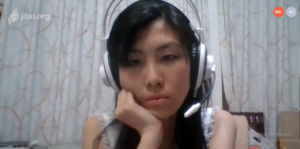
Figure 37
A few months later, Victoria raised the same demands at a further meeting organized by the National Institute against Discrimination, Xenophobia and Racism of Argentina (INADI). This time, she was able to speak to more than sixty representatives of different associations and migrant collectives and to point out the importance of an anti-sinophobic movement to the authorities (37). She particularly stressed three main aspects shaping Sinophobia, as well as potential countermeasures, in Argentina. These included the manipulation of data and the resulting need for education in digital spaces and social networks; the strong tendencies of mass media to distribute false information and their responsibility for verifying their sources; and the need for awareness of racist tendencies in jokes and memes. In addition, she pointed out the necessity of listening to the voices of the migrants themselves and to take them seriously when engaging in public discourses.
On this basis, we define our outcome as the capacity of the formerly silent Chinese minority to reach out to a wider public within their host society, both beyond their own migrant groups and beyond digital media. This outcome, we argue, is manifested by Victoria’s public speeches on Argentine TV and to the public authorities.
Discussion and Conclusion
Along with global developments, racist discrimination against Chinese immigrants in Argentina, their descendants and ethnic Asians in general strongly increased after the outbreak of the global Covid-19 pandemic in 2019. As a response, a wide-reaching countermovement to Sinophobia evolved. The aim of the present study has been to shed light on the process of the Chinese community in Argentina in organizing this structured countermovement. On this basis, we attempted to identify new forms of racialization and digital anti-Sinophobia.
Using an institutionalist lens on racism to identify the bottom-up dynamics of displacement enhanced by the formerly silent Chinese minority, we thus identified the following causal mechanism. Before Covid-19, the mutually reinforcing phenomenon of frequently expressed but rather subtle racism against the Chinese minority in Argentina and the latter’s limited tools with which to respond had constantly shaped the image of a silent minority. Occasional actions to challenge discrimination remained isolated and lacked final improvements. As the more subtle forms of Sinophobia were increasingly institutionalized from the outbreak of Covid-19, their sources and consequences became more visible and increased the need to react.
As a first step, Chinese immigrants in Argentina identified domestic sources of racism, including media discourses, without further reflection, thus enhancing direct discrimination by the host population. Secondly, the wider scope of transnational anti-racist movements, enhanced by both ethnic Chinese and Asian people in third states, and by other racialized groups within and beyond Argentina, were evaluated and used as tools with which to construct a certain ‘toolkit’ adapted to their own increasingly organized movement. This was eased by the extensive use of digital networks allowing the rapid transfer of information. On this basis, ethnic Chinese inhabitants in Argentina began to encourage one another not only to draw increasing attention to ongoing problems, but also to explain prejudices and actively refute them. These increasingly structured counter-reactions finally allowed their profound understanding of their own social position within the Argentine society to emerge. Their systematic identification of necessary steps to empowerment became powerful enough to evoke the attention of state agencies. This allowed the migrants to make their voices heard with the public authorities, thereby providing the basis for potential institutional change at the macro-level.
Although the outcome of the process analysed in this study does not imply a final institutional change to the wide acceptance of Sinophobia in Argentina (yet), the counter-reactions of ethnic Chinese to institutionalized racism strongly indicate a cumulative process heading towards this final goal through displacement. In particular, digital networks have played an increasingly important role in the emergence of anti-racist movements. The case of Argentina thus demonstrates the importance and applicability of digital counter-reactions to racism as a tool allowing formerly silent minorities to make their voices heard. On this basis, we wish to underline the importance of the digital dynamics of anti-racism as a conceptual framework for further research on both racism and social (counter)movements.
|
STEP |
INITIAL ENVIRON- MENT OF INSTITUTIONAL RACISM |
INPUT |
PHASE 1: INTERNAL INFLUENCES |
PHASE 2: EXTERNAL INFLUENCES |
PHASE 3: TOWARDS AN INCREASINGLY ORGANIZED MOVEMENT |
OUTCOME |
|
Observable mechanism |
Subtle racism against Chinese minority ➜ Missing tools to defend themselves: ‘Silent minority’ |
Covid-19 enhancing institutional racism and the necessity for migrants to react |
1) Identification of increasingly sinophobic media discourses 2) Identification of an increasingly directly expressed Sinophobia |
1) Globally increasing Sinophobia and counter movements 2) Globally increasing Asiophobia and counter movements 3) Incorporation of further global and domestic anti-racist movements ➜ ‘Toolkit’ for increasingly explicit identification and expression of concerns |
1) Creation of new spaces for debate 2) Mutual encouragement to act 3) Spontaneous personal discourses 4) Profound comprehension of personal and collective social position |
Organized bottom-up movement of formerly silent minority ➜ Capacity to report experience to a wide audience within the host society and receive support |
Table 1. Illustration of causal mechanisms leading to organized anti-sinophobic activities in Argentina [authors’ elaboration].
Moreover, we argue that the gradual formation of a bottom-up movement was of great importance to the Chinese diaspora. First, its members found the tools and platforms to discuss and defeat prejudices related to Covid-19, and thereby started to challenge the increasingly institutionalized racism being directed against them. Second, further observations after our period of analysis confirm that Chinese immigrants in Argentina continue to share their experiences and denounce racist discrimination. For example, a group of second-generation Chinese immigrants gained much attention and support through their denunciation of racist treatment in an Argentinian shopping centre in late 2020. Similarly, in September 2020, a famous journalist was officially denounced by more than 50 Chinese immigrants and numerous Argentinian supporters for having publicly attacked Chinese people for being responsible for the pandemic (e.g., IProfesional 2020). In sum, the formerly silent minority of Chinese immigrants and their descendants in Argentina has finally found its voice.
Note on the Authors
Clara Baumann is a PhD researcher at the Institute of Sociology of the University of Duisburg- Essen, and a member of the International Max Planck Research School on the Social and Political Constitution of the Economy (IMPRS-SPCE) in Cologne. In her dissertation, she explores the impact of South-South investments for their target-country development, focusing on Chinese FDI in Latin America. Her further research interests include South-South migration, racism, and regimes of inclusion and exclusion in a globalised world. baumann@mpifg.de
Luciana Denardi is a PhD Social Anthropologist (National University of San Martín) and a researcher at the Scientific and Technical National Research Council (CONICET) of Argentina. Since 2012 she has conducted ethnographic fieldwork to explore different aspects of Chinese migration in Buenos Aires. Since then, she published articles based on: identities, associations, rituals, gender and educational issues. Her last publication is: “Today we are all Chinatown : identity struggle and strategic uses of culture in Buenos Aires´s Chinatown” in a compilation titled China in Argentina: Ethnographies of a Global Expansion published by Palgrave Macmillan (2022). ldenardi@unsam.edu.ar
References
Adaszko, D. and Kornblit, A. 2008. Xenofobia en Adolescentes Argentinos: Un Estudio sobre la Intolerancia y la Discriminación en Jóvenes Escolarizados. Revista Mexicana de Sociología 70(1): 147-96.
Beach, D. and R.B. Pedersen. 2013. Process-Tracing Methods: Foundations and Guidelines. Ann Arbor: University of Michigan Press. https://doi.org/10.3998/mpub.2556282
Better, S. 2008. Institutional Racism: A Primer on Theory and Strategies for Social Change. Plymouth: Rowman and Littlefield.
Black Lives Matter. 2021. About. Black Lives Matter. https://blacklivesmatter.com/about/
Bonilla, Y. and J. Rosa. 2015. # Ferguson: Digital Protest, Hashtag Ethnography, and the Racial Politics of Social Media in the United States. American Ethnologist 42(1): 4-17. https://doi.org/10.1111/amet.12112
Bourne, J. 2001. The Life and Times of Institutional Racism. Race and Class 43(2): 7-22. https://doi.org/10.1177/0306396801432002
Carmichael, S. and C. V. Hamilton. 1992. Black Power: The Politics of Liberation in America. New York: Vintage.
Chan, C. and M. Montt Strabucchi. 2021. Many-faced Orientalism: Racism and Xenophobia in a Time of the Novel Coronavirus in Chile. Asian Ethnicity 22(2): 374-394. https://doi.org/10.1080/14631369.2020.1795618
Chang, A. 2013. Denuncias sobre Barrio Chino. Parte 1 y 2. Canal América Noticias, September 14. https://www.youtube.com/watch? v=6D7ufD7g11I and https://www.youtube.com/watch?v=q4kFTJHVf9U&t=917s
Clarín. 2020a. El Mundo ya Está en Emergencia Sanitaria por el Virus Chino. Clarín, January 31. https://www.pressreader.com/argentina/Clarín/20200131/281509343167163.
Clarín. 2020b. En la Ciudad. Confirmaron el Primer Caso de Coronavirus en Argentina. Trasladaron el Paciente a otra Clínica. Clarín, March 3. https://www.Clarín.com/sociedad/coronavirus-confirmaron-primer-caso-argentina-espera-conferencia-gobierno_0_awnywhZX.html
Clarín. 2020c. No Había Control Sanitario. Coronavirus. Las Terribles Imágenes del Mercado Donde se Originó la Pandemia. Clarín, March 13. https://www.Clarín.com/viste/coronavirus-terribles-imagenes-mercado-origino-pandemia_0_Ff7JE-EH.html
Daniels, J. 2013. Race and Racism in Internet Studies: A Review and Critique. New Media and Society 15(5): 695-719. https://doi.org/10.1177/1461444812462849
Denardi, L. 2017. Migraciones Chinas y Taiwanesas en Buenos Aires: Estado, Organizaciones y Rituales. Doctoral thesis, Universidad Nacional de San Martín.
Denardi, L. 2020. Yo No Soy un Virus. Ad Sina, April 28. https://adsina.wordpress.com/2020/04/28/yo-no-soy-un-virus/
Di Prospero, C. 2017. Antropología de lo Digital. Construcción del Campo Etnográfico en Co-presencia. Virtualis 8(15). https://doi.org/10.2123/virtualis.v8i15.219
Djelic, M. L. and S. Quack. 2003. Theoretical Building Blocks for a Research Agenda Linking Globalization and Institutions. In: M.L. Djelic and S. Quack, eds., Globalization and Institutions. Redefining the Rules of the Economic Game, 15-34. Cheltenham: Edward Elgar Publishing. https://doi.org/10.4337/9781781950012.00010
Djelic, M. L. and S. Quack. 2008. Institutions and Transnationalization. In: R. Greenwood, C. Oliver, R. Suddaby, and K. Sahlin, eds., The Sage Handbook of Organizational Institutionalism, 299-323. Los Angeles: Sage Publications. https://doi.org/10.4135/9781849200387.n12
Dulitzky, A. 2005. A Region in Denial. Racial Discrimination and Racism in Latin America. In: A. Dzidzienyo and S. Oboler, eds., Neither Enemies nor Friends, 39-59. New York: Palgrave Macmillan. https://doi.org/10.1057/9781403982636_2
Ekman, M. 2019. Anti-immigration and Racist Discourse in Social Media. European Journal of Communication 34(6): 606-618. https://doi.org/10.1177/0267323119886151
España Eljaiek, I. 2017. Actors, Institutional Change and Reproduction The Colombian Case of Racial Exclusion and Local Socio-Economic Performance 1886-1950. Dissertation, International Max Planck Research School on the Social and Political Constitution of the Economy.
Golash-Boza, T. and E. Bonilla-Silva. 2013. Rethinking Race, Racism, Identity and Ideology in Latin America. Ethnic and Racial Studies 36(10): 1485-1489.
Inadi, 2020. La Discriminación en Tiempos de Coronavirus. Reflexiones sobre el Uso de las Redes en una Pandemia. Instituto Nacional Contra la Discriminación, la Xenofobia y el Racismo. https://www.argentina.gob.ar/sites/default/files/la_discriminacion_en_tiempos_de_coronavirus.pdf
IProfesional. 2020. Feinmann Volvió a la TV con un Exabrupto Hacia los Chinos que Generó un Fuerte Repudio. IProfesional, September 23. https://www.iprofesional.com/actualidad/324140-feinmann-volvio-a-la-tv-con-un-fuerte-exabrupto-hacia-los-chinos
Jonas, K., and Schmid Mast, M. 2007. Stereotyp und Vorurteil. In: J. Straub, A. Weidemann, and D. Weidemann, eds., Handbuch Interkulturelle Kommunikation und Kompetenz, 69-76. Stuttgart: J.B. Metzler. https://doi.org/10.1007/978-3-476-05019-9
Labarca, C. 2015. Ni Hao Mr. Pérez. Buenos Días
Mr. Li. Chile y China: Cultura, Negocios y Confianza en la Era Global. Santiago de Chile: Ediciones UC.
Lan, S. 2011. Diaspora and Class Consciousness: Chinese Immigrant Workers in Multiracial Chicago. New York: Routledge. https://doi.org/10.4324/9780203128077
Lan, S. 2016. The Shifting Meanings of Race in China: A Case Study of the African Diaspora Communities in Guangzhou. City and Society 28(3): 298-318. https://doi.org/10.1111/ciso.12094.
La Nación. 2020. Coronavirus. Afirman que Volvió la Venta de Carne de Murciélagos en China. La Nación, March 29. https://www.lanacion.com.ar/el-mundo/coronavirus-segun-diario-ingles-mercados-chinos-siguen-nid2348579
Lausent-Herrera, I. 2014. Between Catholicism and Evangelism: The Peruvian Chinese Community. In: C-.B. Tan, ed., Chinese Overseas: Religions, Identity and Transnational Networks, 185-240. Singapore: World Scientific. https://doi.org/10.1142/9789814590006_0008
Manchester Digital Exhibitions. (n.d.) Identidad Marrón. Manchester Digital Exhibitions. https://www.digitalexhibitions.manchester.ac.uk/s/carla-es/page/identidad-marron
Matamoros-Fernández, A. 2017. Racismo en Plataformas: La Mediación y Circulación de una Controversia Australiana Basada en la Raza en Twitter, Facebook y YouTube. Information, Communication and Society 20(6): 930-946. https://doi.org/10.1080/1369118x.2017.1293130
Molina, I. .2019. Consumo de Medios en Argentina: El 25% de la Audiencia la Concentra el Grupo Clarín. Laboratorio de Periodismo Luca de Tena, May 7. https://laboratoriodeperiodismo.org/consumo-de-medios-en-argentina-el-25-de-la-audiencia-la-concentra-el-grupo-clarin/
Mullings, L. 2005. Interrogating Racism: Toward an Antiracist Anthropology. Annual Review of Anthropology 34: 667-693. https://doi.org/10.1146/annurev.anthro.32.061002.093435
Murji, K., and J. Solomos. 2005. Introduction: Racialization in Theory and Practice. In: K. Murji and J. Solomos, eds., Racialization. Studies in Theory and Practice, 1-27. New York: Oxford University Press.
Nelson, J. K. 2013. Denial of Racism and its Implications for Local Action. Discourse and Society 24(1): 89-109. https://doi.org/10.1177/0957926512463635
Ovrik 2018. Dime qué Edad Tienes y te Diré la Red Social Utilizas: Qué Usan las Distintas Generaciones en Argentina. Ovrik, August 6. http://www.ovrik.com/2018/08/06/redes-sociales-populares-edad-argentina/.
Quack, S. and M.L. Djelic. 2005. Adaptation, Recombination and Reinforcement: The Story of Antitrust and Competition Law in Germany and Europe. In: W. Streeck and K. Thelen, eds., Beyond Continuity. Institutional Change in Advanced Political Economies, 255-281. New York: Oxford University Press.
Reeves, F. 1983. British Racial Discourse: A Study of British Political Discourse about Race and Race-related Matters. Cambridge: Cambridge University Press. https://doi.org/10.1017/cbo9780511898150
Rubio, E. H. 2021. Black‐Asian Solidarities and the Impasses of How‐to Anti‐racisms. Journal for the Anthropology of North America 24(1): 16-31. https://doi.org/10.1002/nad.12139
Streeck, W. and K. Thelen. (eds.) 2005. Beyond Continuity: Institutional Change in Advanced Political Economies. Oxford: Oxford University Press.
Sue, C. 2009. An Assessment of the Latin Americanization Thesis. Ethnic and Racial Studies 32(6): 1058-1070. https://doi.org/10.1080/01419870902802262
Suler, J. 2004. El Efecto de Desinhibición Online. Ciberpsicología y Comportamiento 7(3): 321-326. https://doi.org/10.1089/1094931041291295
Sutton, B. 2008. Contesting Racism. Democratic Citizenship, Human Rights, and Antiracist Politics in Argentina. Latin American Perspectives 35(6): 106-21. https://doi.org/10.1177/0094582×08326022
Tang, F. W. 2011. 挑战与回应. 阿根廷华人超市行业现状研究 (Challenges and Reactions. Research on the Current Situation of the Chinese Supermarket Industry in Argentina). 八桂侨刊 (Overseas Journal of Bagui) (4): 25-30.
Tronfi, A. 2020. Una Hija de Comerciantes Chinos: Discriminada en la Escuela por Miedo a Contagiarse de Coronavirus. La Nación, March 4. https://www.lanacion.com.ar/sociedad/una-nena-hija-comerciantes-chinos-discriminada-escuela-nid2339706/.
Tsuda, T. 1999. The Motivation to Migrate: The Ethnic and Sociocultural Constitution of the Japanese-Brazilian Return-Migration System. Economic Development and Cultural Change 48(1): 1-31. https://doi.org/10.1086/452444
Waters, S. 2003. Social Movements in France: Towards a New Citizenship. London: Palgrave Macmillan. https://doi.org/10.1057/9781403948229
Wang, S., X. Chen, Y. Li, C. Luu, R. Yan, and F. Madrisotti. 2020. ‘I’m More Afraid of Racism than of the Virus!’ Racism Awareness and Resistance among Chinese Migrants and Their Descendants in France during the Covid-19 Pandemic. European Societies 23: S721-S742. https://doi.org/10.1080/14616696.2020.1836384
Willie, G. 2020. Coronavirus: Qué Esconde la Sopa de Murciélago a la que Culpan por la Pandemia. La Nación, April 2. https://www.lanacion.com.ar/sociedad/coronavirus-sopa-murcielago-china-pandemia-nid2350020.
Yeh, D. 2020. Covid-19, Anti-Asian Racial Violence, and the Borders of Chineseness. British Journal of Chinese Studies 10. https://bjocs.site/index.php/bjocs/article/view/117.
New Diversities • Volume 24, No. 1, 2022
Special issue: Covid-19 and the Racialisation of Migrants in the Global South
Guest Editors: SHANSHAN LAN (University of Amsterdam), WILLY SIER (Utrecht University) and ALDINA CAMENISCH (University of Neuchâtel)
- ISSN-Print 2199-8108
- ISSN-Internet 2199-8116
- The related discourse of the ‘‘model minority’’ generally refers to Chinese and other East and South-East Asian migrant groups and highlights their successful integration in their host society and its labour market, usually through hard labour and determination. Thereby, they are rarely suspected to be involved in any conflict (Lan 2016; Yeh 2020). In contrast, several of our interlocutors who were second-generation Chinese immigrants in Argentina affirmed that their parents ‘‘did not talk too much’’ about discrimination merely because ‘‘they were immigrants in a country that had accepted them’’. For these reasons, we refer to the Chinese diaspora in Argentina as a ‘silent’ rather than a ‘model minority’.
- We thank our anonymous reviewers for pointing out this essential distinction.
- We understand that the mobilization of young Chinese immigrants and their descendants aims for stronger social recognition in Argentina. This includes their claims for respectful treatment and for the de-exoticization of their communities and practices (compare Mullings’ (2005: 684) categorization of social movements).
- To communicate with their homeland or other members of the Chinese diaspora, Chinese emigrants mainly use the (Chinese) multifunctional messaging service of WeChat, which enables both the exchange of private messages and the dissemination of public posts. Hence, their use of Instagram and Facebook reveals their need to communicate with people outside these communities.
- Although no official data on the number of active Chinese users of social networks in Argentina have been collected to date, the large number of their shared groups on Facebook, as well as their numerous individual members, indicate a high level of resonance (e.g., ‘‘阿 根廷華人互助會,Grupo de ayuda mutua para chinos en Argentina, armonia mundial 小组’’: over 2,500 members (https://www.facebook.com/groups/argentinachinos/); “Cultural Chino Argentina”: over 5.300 members (https://www.facebook.com/groups/27556186068/), last retrieved: 17.02.2022).
- To avoid potential research biases that could derive from automatically created algorithms on online platforms, first, we included a wide range of 400 different screenshots from numerous Chinese people of diverse backgrounds. Second, we not only analysed the personal accounts of individual persons but verified our findings through the observation of more general discussions in Facebook groups, which unite diverse members and opinions of the Chinese communities in Argentina.
- With the exception of INADI (2020), which engaged in publishing relevant documents.
- As the sources used by our interlocutors have mainly been taken from Argentina’s biggest newspapers, Clarín and La Nación, we follow their example by including them in this paper. Clarín belongs to Argentina’s largest and most influential telecommunications company, Grupo Clarín, and leads sales with 206,000 copies daily. It is followed by the 103,000 copies of La Nación. Both have a politically right-wing orientation (Molina 2019).
- The related screenshots can be identified by their number listed within parentheses.
- All names and personal information of research participants have been omitted or replaced by pseudonyms. Exceptions are those who have explicitly given us their permission to use their personal data for publication.
- With the exception of transnational influences as elaborated below, all cited comments were originally published in Spanish.
- We thank Diana Yeh for her insightful remark on anti-Asian racism at our workshop.
- ‘Brown Identity is an organization dedicated to problematizing structural, institutional and interpersonal racism; it is a political, legal, artistic and cultural approach from the Global South [...] to promote a fighting tool to vindicate the skins and faces of the children and grandchildren of indigenous people, peasants, internal and international migrants’ (Manchester Digital Exhibitions, n.d.).
